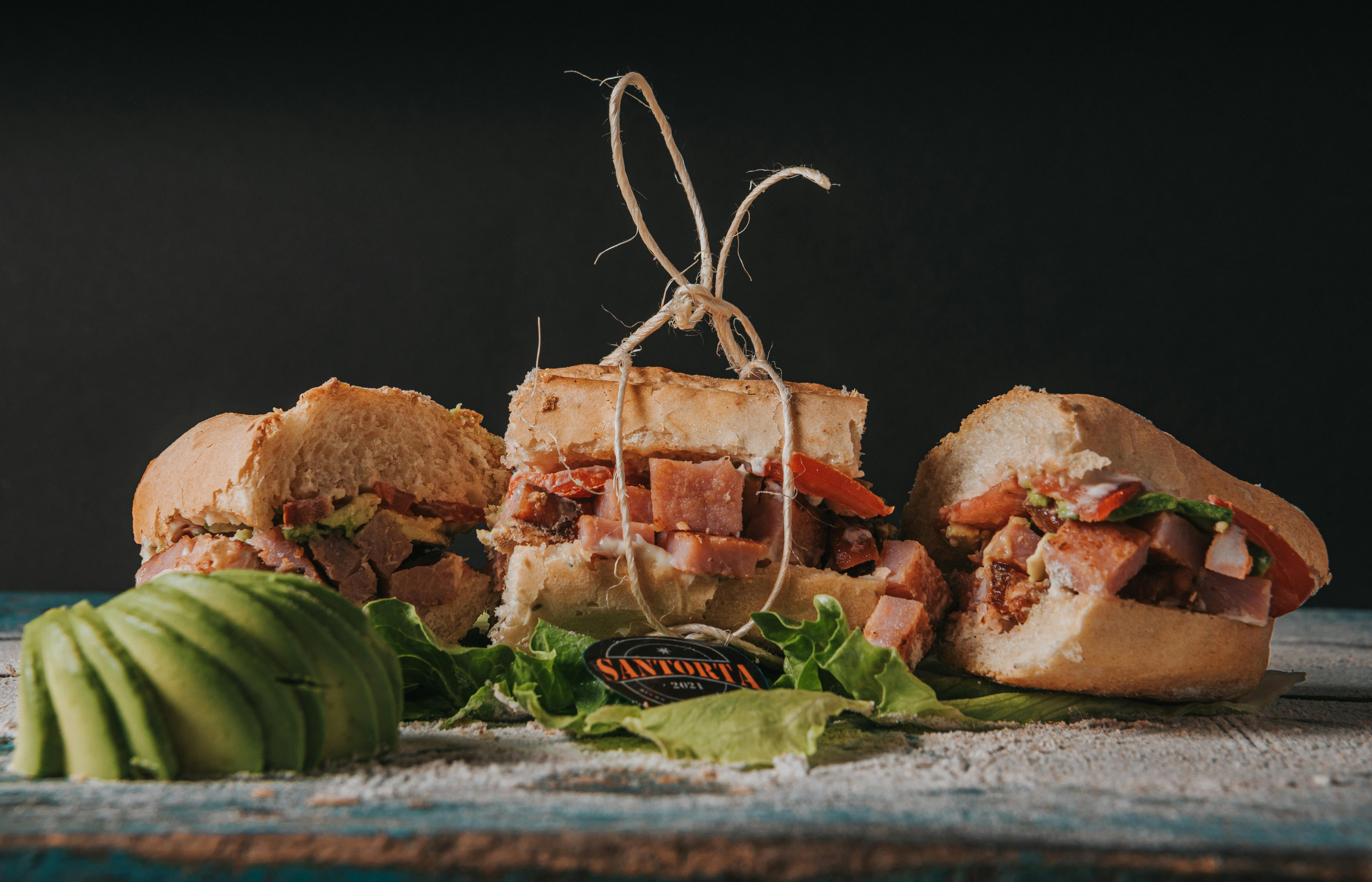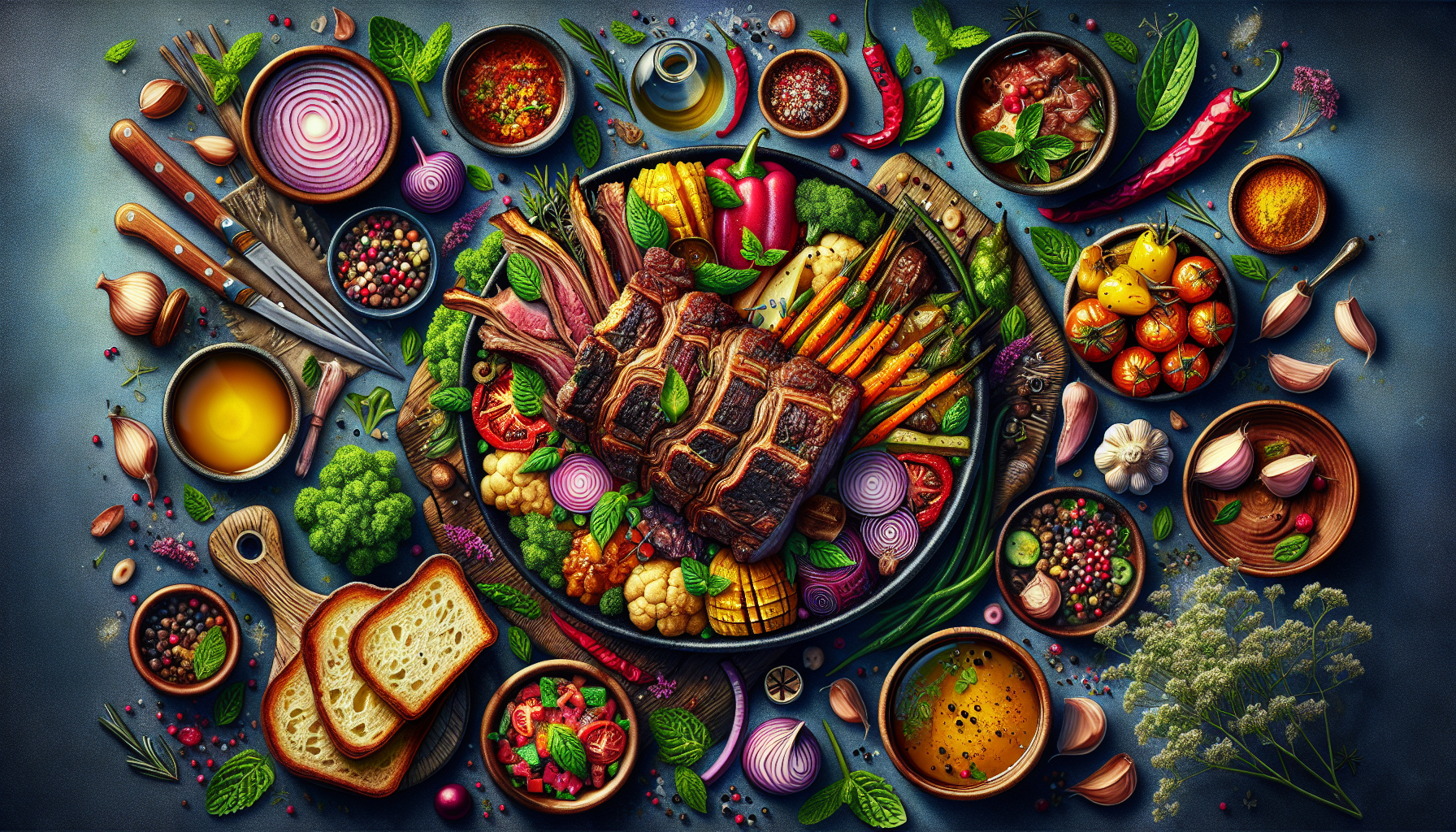Embark on a delectable journey as you dive into the culinary wonders of the Balkans. Whether you’re a seasoned chef or a kitchen novice, Tastepan.com has your taste buds covered with an array of tantalizing recipes and traditions. From hearty comfort foods that warm the soul to unique and exotic dishes that will transport you to far-off lands, our curated collection is sure to inspire your inner foodie. With detailed instructions, ingredient lists, and expert tips, you’ll be creating mouthwatering meals that will impress even the most discerning palates. Get ready to embark on a flavorful adventure as we explore the rich tapestry of Balkan cuisine.

Balkan Cuisine: An Introduction
Welcome to the world of Balkan cuisine! A culinary journey through the countries of the Balkan Peninsula is sure to delight your taste buds and provide a window into the rich and diverse culture of the region. Balkan cuisine is a glorious fusion of flavors, traditions, and influences from various cultures and civilizations. From hearty meat dishes to delectable desserts, there is something for everyone to savor and enjoy. In this article, we will explore the key aspects of Balkan cuisine, regional variations, traditional dishes, desserts, beverages, street food, cooking techniques and tools, as well as the importance of preserving culinary traditions. So, put on your apron, grab your utensils, and let’s embark on a gastronomic adventure together!
A Brief Overview of Balkan Cuisine
Balkan cuisine is a fascinating tapestry of flavors, textures, and aromas that reflect the region’s historical and geographical diversity. Situated at the crossroads of Europe, Asia, and the Mediterranean, the Balkans have been influenced by a myriad of civilizations, including the Byzantines, Ottomans, Austro-Hungarians, and Venetians. This rich tapestry of cultural influences is beautifully woven into Balkan cuisine, resulting in a unique and tantalizing gastronomic experience.
Influences on Balkan Cuisine
The diverse influences on Balkan cuisine have shaped the flavors and techniques used in preparing traditional dishes. The Ottomans, for instance, introduced the concept of slow-cooked stews and the use of aromatic spices like cinnamon, allspice, and cumin. The Austro-Hungarians, on the other hand, brought the tradition of hearty meat dishes and the use of dairy products. The Mediterranean influence is evident in the abundant use of fresh herbs, olive oil, and seafood. All of these influences come together to create the splendid flavors that define Balkan cuisine.

Key Ingredients in Balkan Cuisine
The Balkans are blessed with a bounty of fresh and flavorful ingredients that form the backbone of many traditional dishes. Some of the key ingredients commonly used in Balkan cuisine include:
-
Meat: Balkan cuisine is known for its love of meat, with dishes often featuring lamb, pork, beef, and poultry. These meats are often cooked using slow-cooking methods to achieve tender and succulent results.
-
Fresh Herbs and Spices: The use of fresh herbs such as parsley, dill, and mint adds a vibrant and aromatic touch to many Balkan dishes. Common spices include paprika, garlic, and black pepper.
-
Dairy Products: Balkan cuisine is renowned for its delicious dairy products, especially various types of cheese and yogurt. These creamy delights are used in a variety of dishes, both savory and sweet.
-
Vegetables: The Balkans offer an abundance of fresh and flavorful vegetables, including tomatoes, peppers, eggplants, and zucchini. These vegetables are often the stars of various dishes, either stuffed, roasted, or grilled to perfection.
-
Grains and Legumes: Grains such as rice and bulgur are commonly used in pilaf dishes, while legumes like beans and lentils feature prominently in hearty stews and soups.
Now that we have a general understanding of the key aspects of Balkan cuisine, let’s dive deeper into some of the traditional dishes that make this cuisine so special.
Traditional Balkan Dishes
Burek
Burek is a beloved pastry dish found throughout the Balkans. It consists of thin layers of flaky pastry, usually filled with meat, cheese, or spinach. Burek is a staple breakfast or snack food and is enjoyed by locals and visitors alike.
Cevapi
Cevapi, also known as cevapcici, is a popular Balkan street food that consists of small, grilled sausages made from minced meat, usually a mix of beef and lamb. The sausages are typically served with traditional flatbread called lepinja and garnished with onions and ajvar, a delicious roasted red pepper and eggplant relish.
Moussaka
Moussaka is a classic Balkan dish made with layers of sliced potatoes, eggplants, and minced meat, usually lamb. The dish is baked in the oven with a creamy bechamel sauce, resulting in a hearty and flavorful casserole. Moussaka is a staple at family gatherings and celebratory occasions.
Sarma
Sarma is a traditional Balkan dish that consists of cabbage leaves stuffed with a flavorful mixture of ground meat, rice, and spices. The stuffed cabbage rolls are then simmered in a tangy tomato sauce until tender and delicious. Sarma is typically served with a dollop of sour cream and crusty bread.
Ajvar
Ajvar is a mouthwatering roasted red pepper and eggplant relish that is a staple in Balkan cuisine. This flavorful condiment can be used as a spread, a sauce, or a dip, and adds a burst of flavor to any dish. Ajvar is often homemade, using grilled or roasted vegetables that are pureed with garlic, olive oil, and vinegar.
Now that we have explored some of the traditional dishes, let’s take a closer look at the regional variations in Balkan cuisine.
Regional Variations
The Balkan Peninsula is home to a diverse range of culinary traditions, with each country having its own unique spin on traditional dishes. Let’s explore some of the regional variations in Balkan cuisine.
Croatia
Croatian cuisine is influenced by its coastal location and Mediterranean climate. Seafood, olive oil, and fresh herbs are common ingredients in Croatian dishes. Traditional Croatian dishes include peka, a slow-cooked dish of meat or seafood, and zagorski štrukli, a baked pastry filled with cheese and served with sour cream.
Serbia
Serbian cuisine is known for its hearty meat dishes and robust flavors. Grilled meats, such as cevapi and pljeskavica, are popular street food options. Additionally, Serbian cuisine features a variety of stews, such as goulash and sarma, which are typically enjoyed during festive occasions.
Bulgaria
Bulgarian cuisine is a harmonious blend of Eastern European and Mediterranean flavors. Traditional Bulgarian dishes include banitsa, a savory pastry filled with cheese and eggs, and shopska salad, a refreshing salad made with tomatoes, cucumbers, peppers, and crumbled feta cheese.
Macedonia
Macedonian cuisine is characterized by its simplicity and use of fresh, local ingredients. Tavče gravče, a traditional Macedonian bean stew, and ajvar, a roasted red pepper and eggplant relish, are iconic dishes in Macedonian cuisine.
Slovenia
Slovenian cuisine is heavily influenced by its neighbors, including Italy, Austria, and Hungary. Slovenian dishes often feature a combination of different influences, resulting in unique and delicious flavors. Some popular Slovenian dishes include potica, a traditional rolled pastry with various fillings, and kranjska klobasa, a Slovenian sausage.
Now that we have explored the regional variations, let’s satisfy our sweet tooth with some delectable Balkan desserts.

Balkan Desserts
Balkan cuisine is known for its mouthwatering array of desserts, ranging from rich and indulgent pastries to delicate and fragrant sweet treats. Let’s tantalize our taste buds with some traditional Balkan desserts.
Baklava
Baklava is a sweet and flaky pastry made with layers of filo dough, nuts, and a sweet syrup made of honey, lemon, and spices. This delightful dessert is enjoyed throughout the Balkans, with each country adding its own unique touch to the recipe.
Tulumbe
Tulumbe are deep-fried pastry tubes soaked in a sweet sugar syrup. They are crispy on the outside and soft and syrupy on the inside. Tulumbe are often served as a special treat during festive occasions and celebrations.
Kadaif
Kadaif, also known as kataifi, is a shredded pastry dessert soaked in a sweet syrup and filled with a variety of fillings, such as nuts or cream. It is a deliciously sweet and indulgent dessert that is enjoyed across the Balkans.
Kremna Rezina
Kremna rezina, also known as krempita, is a classic Balkan dessert made with layers of flaky pastry and a rich vanilla custard filling. The top layer is usually dusted with powdered sugar and decorated with swirls of whipped cream. This dessert is a true crowd-pleaser.
Trilece
Trilece is a moist and decadent cake soaked in a sweet milk syrup. It is made with three types of milk – evaporated milk, condensed milk, and heavy cream – hence the name “trilece,” which means “three milks” in Serbian. This cake is a true delight for dessert lovers.
Now that our sweet tooth has been satisfied, let’s quench our thirst with some refreshing Balkan beverages.
Balkan Beverages
Balkan beverages are as diverse and flavorful as the cuisine itself. Let’s explore some popular beverages that are enjoyed in the Balkans.
Rakija
Rakija is a traditional fruit brandy that is a symbol of Balkan hospitality. It is distilled from various fruits, such as plums, apricots, and grapes. Rakija is often enjoyed as an aperitif or digestif and is seen as a quintessential Balkan drink.
Boza
Boza is a thick and slightly fermented beverage made from grains, typically wheat or corn. It is sweet and tangy in flavor and has a distinctively creamy texture. Boza is often enjoyed during the winter months and is sometimes served with a sprinkle of cinnamon on top.
Ayran
Ayran is a refreshing yogurt-based drink that is popular in many Balkan countries. It is made by diluting yogurt with water and adding a pinch of salt. Ayran is a popular accompaniment to grilled meats and is enjoyed as a cool and hydrating beverage on hot summer days.
Salep
Salep is a warm and creamy beverage made from ground orchid tubers. It has a delicate floral flavor and is often enjoyed during the winter months. Salep is traditionally served with a sprinkle of cinnamon or crushed pistachios on top.
Kafa
Kafa, or Turkish coffee, is an integral part of Balkan culture. It is a strong and aromatic coffee brewed in a special cezve, or ibrik, and served in small cups. Kafa is often enjoyed with a cube of sugar and a glass of water on the side.
Now that we have explored the delightful world of Balkan cuisine and beverages, it’s time to indulge in a traditional Balkan feast with some festive recipes.
Traditional Balkan Feast: Festive Recipes
A traditional Balkan feast is a celebration of flavors, traditions, and togetherness. Let’s explore some festive recipes that are sure to impress your guests and transport them to the heart of the Balkans.
Lamb Kleftiko
Lamb Kleftiko is a traditional Greek dish that has become popular throughout the Balkans. It consists of slow-cooked lamb, marinated in a fragrant mixture of herbs, garlic, lemon, and olive oil. The lamb is then roasted in a sealed parchment paper parcel, resulting in tender, melt-in-your-mouth meat.
Fish Plaki
Fish Plaki is a delicious and healthy dish that is often enjoyed during Greek or Croatian Easter celebrations. It features fresh white fish, such as cod or snapper, cooked in a flavorful tomato sauce with onions, garlic, herbs, and spices. The addition of Kalamata olives and capers adds a delightful briny flavor to the dish.
Cabbage Rolls
Cabbage rolls, or sarma, are a staple at festive occasions in the Balkans. This comforting dish consists of cabbage leaves stuffed with a flavorful mixture of ground meat, rice, and spices. The stuffed cabbage rolls are then simmered in a tangy tomato sauce until tender and bursting with flavor.
Stuffed Peppers
Stuffed peppers are a popular dish in the Balkans, enjoyed during both everyday meals and special occasions. The peppers are filled with a delicious mixture of ground meat, rice, herbs, and spices, and then roasted until the peppers are soft and the filling is cooked through. It’s a colorful and satisfying dish that exemplifies the flavors of the Balkans.
Spinach Pie
Spinach pie, also known as spanakopita or börek, is a traditional Balkan dish made with layers of flaky filo pastry and a savory filling of spinach, feta cheese, onions, and herbs. The pie is baked until golden and crispy, resulting in a delightful combination of flavors and textures.
Now that we have enjoyed a delicious feast, let’s take a stroll down the streets of the Balkans and explore some mouthwatering street food.
Balkan Street Food
Balkan street food is a vibrant and delicious way to experience the culinary delights of the region. Let’s explore some popular street food options from various Balkan countries.
Bosnian Ćevapi
Bosnian ćevapi is a staple street food in Bosnia and Herzegovina. These small grilled sausages, made from a mixture of ground beef and lamb, are served with traditional flatbread and garnished with onions and ajvar, a roasted red pepper and eggplant relish. Ćevapi are immensely popular and can be found at food stalls and grills throughout the country.
Turkish Doner Kebab
Doner kebab, although originating in Turkey, has become a favorite street food option in many Balkan countries. It consists of succulent strips of marinated meat, usually lamb or chicken, which are slowly roasted on a vertical spit. The meat is then thinly sliced and served in a pita bread or wrap with a selection of fresh vegetables, sauces, and condiments.
Greek Souvlaki
Souvlaki is a classic Greek street food that has also gained popularity throughout the Balkans. It consists of marinated pieces of meat, traditionally pork or chicken, skewered and grilled to perfection. Souvlaki is typically served in a pita bread with tzatziki sauce, tomatoes, onions, and lettuce, making it a delicious and satisfying handheld meal.
Polish Pljeskavica
Pljeskavica is a traditional Serbian dish that has made its way into the street food scene in many Balkan countries. It is a large, grilled patty made from a mixture of minced meats, usually beef, pork, and lamb. Pljeskavica is served in a flatbread with a variety of toppings and condiments, making it a savory and filling treat.
Romanian Mici
Mici, also known as mititei, are small grilled sausages that are popular street food in Romania. The sausages are made with a mixture of ground beef, lamb, and pork, as well as a combination of aromatic spices like garlic, thyme, and coriander. Mici are traditionally served with mustard, fresh bread, and a side of pickles, making it a delicious and satisfying street food option.
Now that we have satisfied our cravings with some delectable street food, let’s explore the cooking techniques and tools that are essential to mastering the art of Balkan cuisine.
Cooking Techniques and Tools
Balkan cuisine encompasses a variety of cooking techniques and tools that are essential in creating the distinct flavors and textures of traditional dishes. Let’s explore some of the key cooking techniques and tools used in Balkan cuisine.
Grilling and Roasting
Grilling and roasting are popular cooking techniques in Balkan cuisine, particularly for meat dishes. Whether it’s cevapi, pljeskavica, or lamb kleftiko, the smoky and charred flavors imparted by grilling and roasting create a delightful depth of flavor. Traditional charcoal grills, such as a mangal or a kono, are often used to achieve that distinct grilled taste.
Peka
Peka is a traditional Balkan cooking technique that involves slow-cooking meat and vegetables in a covered baking dish. The dish is typically placed in a wood-burning oven or buried in hot coals, allowing the ingredients to slowly cook and develop rich flavors. Peka is often associated with Croatian and Serbian cuisine and is used to prepare dishes such as peka lamb and peka potatoes.
Tavče Gravče
Tavče Gravče is a traditional Macedonian dish of stewed beans that is cooked in a special earthenware pot called a tavče. The pot’s shallow and wide shape allows for even heat distribution, resulting in perfectly cooked beans that are tender and full of flavor. This traditional cooking method is used to achieve the distinct taste and texture of Tavče Gravče.
Gibanica
Gibanica is a traditional Balkan layered pastry that requires a specific baking technique to achieve its signature flaky texture. The pastry is made by layering filo dough with various fillings, such as cheese, spinach, or meat. The filo dough is buttered between each layer, and the pastry is baked in a hot oven until golden and crispy.
Dolma Pot
The dolma pot, or Sarma Tenceresi, is a special cooking vessel used to prepare stuffed grape leaves and other dolma varieties. The pot is made of thick and heavy cast iron, which ensures even heat distribution and long-lasting heat retention. This allows the dolmas to cook slowly and retain their shape and flavor. The dolma pot is an essential tool in many Balkan kitchens.
Now that we have explored the cooking techniques and tools, let’s delve into the importance of preserving Balkan culinary traditions.
Preserving Balkan Culinary Traditions
Balkan culinary traditions have been passed down from generation to generation, intertwining with cultural practices and family customs. Preserving these culinary traditions is of great importance as they not only provide a connection to the past but also enrich the present and future. Let’s explore some of the ways in which Balkan culinary traditions are preserved.
Family Customs and Recipes
Balkan families often have their own unique customs and recipes that have been handed down through the generations. These family traditions play a vital role in preserving Balkan culinary heritage. Gathering in the kitchen to prepare meals, teaching younger generations the art of traditional cooking, and passing down cherished recipes are ways in which families keep their culinary traditions alive.
Seasonal Festivals and Foods
Seasonal festivals and foods are an integral part of Balkan culinary traditions. Whether it’s celebrating Christmas Eve with a feast of fish dishes or preparing traditional Easter bread, these seasonal customs and festivals bring families and communities together to honor their culinary heritage. The preparation of specific foods during these festivals ensures the continuation of traditional recipes and techniques.
Culinary Traditions in Modern Balkan Society
While modernization and globalization have brought changes to Balkan society, the preservation of culinary traditions remains a pillar of cultural identity. Many Balkan countries have embraced the promotion of traditional cuisine through food festivals, culinary tours, and initiatives to support local producers. These efforts not only preserve culinary traditions but also contribute to the sustainable development of local communities.
As we near the end of our culinary exploration of the Balkans, let’s delve into the world of Balkan markets and ingredients.
Exploring Balkan Markets and Ingredients
Balkan markets, with their vibrant colors, enticing aromas, and bustling atmosphere, are the heart and soul of the region’s culinary scene. Let’s take a virtual stroll through the markets and explore the unique ingredients that make Balkan cuisine so special.
Local Markets and Bazaars
Local markets and bazaars are treasure troves of fresh produce, spices, dairy products, and meats. These markets offer an opportunity to taste and experience the diverse flavors of the Balkans. From the bustling Grand Bazaar in Istanbul to the ancient Skadarlija Market in Belgrade, there is a market to suit every culinary adventure.
Unique Herbs and Spices
The Balkans are home to a wide range of unique herbs and spices that add depth and complexity to Balkan dishes. From the smoky aroma of paprika to the earthy notes of thyme and oregano, Balkan cuisine is infused with a plethora of flavors. Exploring local markets allows you to discover these aromatic treasures and experiment with new and exciting flavors.
Balkan Cheese and Dairy Products
Balkan cuisine is synonymous with its rich and diverse cheese and dairy products. From the creamy feta cheese of Greece to the tangy kajmak of Serbia, there is a wide variety of cheeses to discover. Exploring local markets allows you to taste and purchase these delicious dairy products, ensuring an authentic Balkan culinary experience.
Meat and Seafood Varieties
Balkan markets boast a wide array of meats and seafood, showcasing the region’s love of hearty and flavorsome dishes. Freshly caught fish from the Adriatic Sea, succulent meats from local farms, and an abundance of cured and smoked meats are just a few examples of the culinary delights that can be found in Balkan markets.
Balkan Wines and Spirits
Balkan markets are also a great place to discover the region’s diverse wines and spirits. From full-bodied red wines of Macedonia to the honey-infused liqueurs of Croatia, the Balkans have a vibrant and varied wine and spirits culture. Exploring the local markets allows you to taste and experience the unique flavors that have made Balkan beverages renowned around the world.
As we conclude our culinary exploration of the Balkans, it’s evident that this region offers a feast for the senses. The rich flavors, unique ingredients, and diverse cultural influences all contribute to the tapestry that is Balkan cuisine. Whether you’re enjoying traditional dishes at a family gathering, savoring street food in a bustling market, or exploring the vibrant flavors of Balkan desserts, each bite tells a story of history, tradition, and love. So, embrace the warmth of Balkan hospitality, and let the flavors of this enchanting region transport you on a truly unforgettable culinary adventure.

